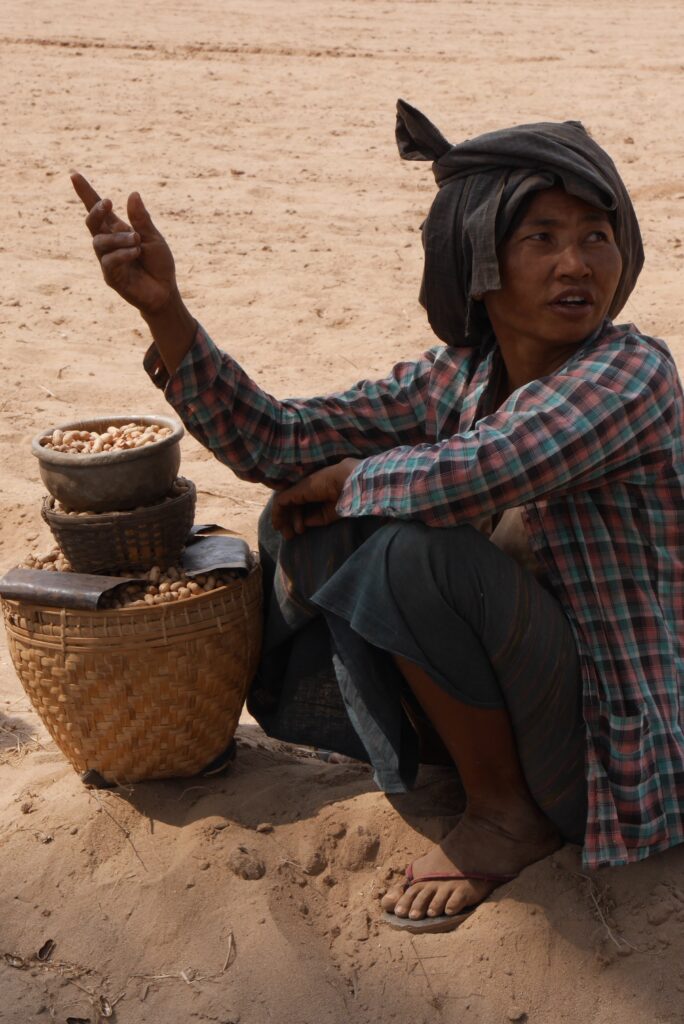In the dry and arid central region of Myanmar, climate risks mean more intense and longer dry spells and frequent droughts. Village communities mostly eke out a living growing peanuts and sesame and raising livestock. But as water for drinking and farming gets scarce, many communities are coping by moving to the cities in search of work.
Thin Thin Yu makes a living picking and shelling groundnuts or collecting grass for livestock. She can get about 400 (US$ 0.30) kyats for collecting 3kg of peanuts with which she buys a kilo of rice for her family. She has two children aged 3 and 11. Her husband is not able to find work as there’s not much demand for construction or hired labor. She owns neither land nor livestock.
Every morning and evening, she walks about a kilometer to the local pond to fetch water for washing, drinking and cooking.
“It’s very hard to get water and it’s too far to fetch the water” she said. She cannot buy water as she cannot afford it: “One cart of water costs 1,000 kyats (US$0.73). If I fetch water on my own, I can do it only one or two times a day because [the pond] is far away”.
Thin Thin Yu’s village of Nga Pyaw Kan in Yay Nan Chaung Township in central Myanmar is typical of most rural communities in Myanmar’s “dry zone”, considered one of the most natural resource poor regions in Myanmar.

Village communities in central Myanmar mostly grow groundnuts or sesame and raise livestock. Photo: Pin Pravalprukskul / SEI.
The dry zone stretches across the southern part of Sagaing Division, the western and middle part of Mandalay Division and most parts of Magway Division.
Water is scarce in this harsh landscape covered by thin vegetation and dry, wind-beaten soil.
Chronic poverty is now coupled with increasingly hotter dry seasons and more frequent and longer periods of drought posing considerable livelihood challenges for many rural communities.
In the same village, U Phyu Lone is a bit more fortunate as he has a few acres of farmland to grow peanut and sesame and livestock including goats that he sells for cash income. He is very worried about the increasing dry spells and both the infrequent and inadequate rainfall.
“Only this year [2017], we got some good rains. In the past, we could harvest only one crop while another was lost [to drought]. We get rain only in the beginning and end of the [southwest] monsoon. But even this year, the rain in this locality of seven villages fell during different months. Some villages didn’t get enough rain until the very end of the monsoon,” he said.
U Than Soe, a former headman of Lun Pin Sho village in the same township, says that the communities are aware of the changing weather patterns and the impact on their crops and livelihoods is making people look for other livelihood options.
He says that 30 years ago, it was quite different as they had sufficient rains and natural ponds for water.
“Now we have to spend a lot of time to struggle to get water. We have to buy water. We didn’t have to buy 30 years ago. We had natural ponds. We had fewer wells at that time. Now those ponds are dried. They were made by digging with own hands to get water underneath. We used them for free. They are gone now”, he said.

Villagers have to travel further to fetch water as ponds nearer the villages dry out. Photo: Rajesh Daniel / SEI.
Migration for work is often a key coping strategy. The drought and frequent dry spells combined with lack of work and income is making people to move away from their homes in search of livelihoods.
“Many people go to Mandalay and Yangon,” said U Than Soe. “There are people who go to the sea to work as hired labor. Many people go to Thailand and Malaysia, some to China.
“In some houses, maybe one or two persons leave. Almost 50 households have at least some people who have left. Almost half of the village has left to Yangon and Mandalay,” said U Than Soe.
How is climate change affecting the rural communities in Myanmar? How are they coping with climate risks? Watch the short film “The Last Drop” to learn more about climate risks and water insecurity in Myanmar. Producer: Rajesh Daniel, SEI. Produced by Sustainable Mekong Research Network (SUMERNET), SEI Asia.
In the dry and arid central region of Myanmar, climate risks mean more intense and longer dry spells and frequent droughts. Village communities mostly eke out a living growing peanuts and sesame and raising livestock. But as water for drinking and farming gets scarce, many rural people are coping by moving to the cities in search of work.
In central Myanmar, climate risks are worsening local livelihoods as dry seasons get longer and more intense; most young people are migrating to the cities. Video: Rajesh Daniel, SEI / YouTube.
Design and development by Soapbox.